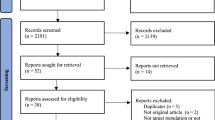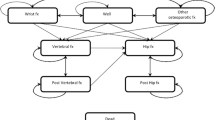Abstract
Summary
This paper assessed the cost-effectiveness of the treatment of high risk women with osteoporosis, hypertension and hyperlipidaemia in Sweden, using one model and a societal perspective. Cost-effective scenarios were found in all these chronic disorders. These findings are of relevance for decisions on the efficient allocation of health care resources.
Introduction
There is a need to assess the cost-effectiveness (CE) of treatment of osteoporosis from a societal perspective and to relate this to the CE of interventions in other disease areas. This is of relevance for decisions on the efficient allocation of health care resources within and between disease areas. The purpose of the paper was to estimate the CE of the treatment and prevention of osteoporosis and to put that into the perspective of treating hypertension and hyperlipidaemia. The CE was assessed for different high risk female populations aged 50–80 years.
Methods
The estimation of CE was based on a model populated with data for Sweden.
Results
Compared to no intervention, a 5-year treatment of osteoporosis, hypertension, and hyperlipidaemia, is cost effective for most of the assessed high risk female populations. The cost per gained quality adjusted life year (QALY) for the treatment of a 70-year-old woman never exceeded SEK 330,000 (US$ 44,000), which is generally judged as an acceptable cost for a gained QALY.
Conclusions
The study demonstrates that it is possible to produce reliable estimates of the CE of treatments in different disease areas within the context of a single model.


Similar content being viewed by others
References
Zethraeus N, Borgstrom F, Strom O, Kanis JA et al (2007) Cost-effectiveness of the treatment and prevention of osteoporosis-a review of the literature and a reference model. Osteoporos Int 18:9–23
Zethraeus N, Ben Sedrine W, Caulin F, Corcaud S et al (2002) Models for assessing the cost-effectiveness of the treatment and prevention of osteoporosis. Osteoporos Int 13:841–857
Fleurence RL, Iglesias CP, Torgerson DJ (2006) Economic evaluations of interventions for the prevention and treatment of osteoporosis: a structured review of the literature. Osteoporos Int 17:29–40
Anderson GL, Limacher M, Assaf AR, Bassford T et al (2004) Effects of conjugated equine estrogen in postmenopausal women with hysterectomy: the Women’s Health Initiative randomized controlled trial. JAMA 291:1701–1712
Rossouw JE, Anderson GL, Prentice RL, LaCroix AZ et al (2002) Risks and benefits of estrogen plus progestin in healthy postmenopausal women: principal results from the Women’s Health Initiative randomized controlled trial. JAMA 288:321–333
Zethraeus N, Borgstrom F, Jonsson B, Kanis J (2005) Reassessment of the cost-effectiveness of hormone replacement therapy in Sweden: results based on the Women’s Health Initiative randomized controlled trial. Int J Technol Assess Health Care 21:433–441
Zethraeus N, Borgström F, Jönsson B, Kanis J (2004) A reassessment of the cost-effectiveness of hormone replacement therapy in Sweden - results based on the Women’s Health Initiative randomised controlled trial. Working Paper Series in Economics and Finance at the Stockholm School of Economics, 2004, Working paper No 571 http://swopec.hhs.se/hastef/papers/hastef0571.pdf
Stevenson M, Jones ML, Davis S, Beverly C (2005) Extract from DSU report: Osteoporosis - primary prevention. http://wwwniceorg.uk/pageaspx?o=273738
Black DM, Schwartz AV, Ensrud KE, Cauley JA et al (2006) Effects of continuing or stopping alendronate after 5 years of treatment: the Fracture Intervention Trial Long-term Extension (FLEX): a randomized trial. JAMA 296:2927–2938
Greenspan SL, Emkey RD, Bone HG, Weiss SR et al (2002) Significant differential effects of alendronate, estrogen, or combination therapy on the rate of bone loss after discontinuation of treatment of postmenopausal osteoporosis. A randomized, double-blind, placebo-controlled trial. Ann Intern Med 137:875–883
Shepherd J, Cobbe SM, Ford I, Isles CG et al (2004) Prevention of coronary heart disease with pravastatin in men with hypercholesterolemia. 1995. Atheroscler Suppl 5:91–97
Hebert PR, Moser M, Mayer J, Glynn RJ et al (1993) Recent evidence on drug therapy of mild to moderate hypertension and decreased risk of coronary heart disease. Arch Intern Med 153:578–581
SBU (1994) [The Swedish Council on Technology Assessment in Health Care]. Moderately elevated blood pressure. Report No 121. Stockholm
SBU (2004) [The Swedish Council on Technology Assessment in Health Care]. Moderately elevated blood pressure - a systematic review. Report No 170. Stockholm
Johannesson M (2001) At what coronary risk level is it cost-effective to initiate cholesterol lowering drug treatment in primary prevention? Eur Heart J 22:919–925
Johannesson M, Hedbrant J, Jonsson B (1991) A computer simulation model for cost-effectiveness analysis of cardiovascular disease prevention. Med Inform (Lond) 16:355–362
Jönsson B, Hedbrant J, Johnell O (1993) A computer simulation model to analyse the cost-effectiveness of fracture prevention of osteoporosis. EFI Research paper Nr 6525
Borgstrom F, Zethraeus N, Johnell O, Lidgren L et al (2006) Costs and quality of life associated with osteoporosis-related fractures in Sweden. Osteoporos Int 17:637–650
Strom O, Borgstrom F, Zethraeus N, Johnell O et al (2007) Long term costs and quality of life associated with osteoporosis related fractures in Sweden. accepted in Acta Orthopaedica (September)
Wolf PA, D’Agostino RB, Belanger AJ, Kannel WB (1991) Probability of stroke: a risk profile from the Framingham Study. Stroke 22:312–318
Wilson PW, D’Agostino RB, Levy D, Belanger AM et al (1998) Prediction of coronary heart disease using risk factor categories. Circulation 97:1837–1847
Hellenius M, Rosell M, Sandgren J (2000) High prevalence of overweight and metabolic syndrome among 60 year old women and men in Stockholm, Sweden. 12th International Symposium on Atherosclerosis Stockholm
Kanis JA, Johnell O, Oden A, Jonsson B et al (2000) Risk of hip fracture derived from relative risks: an analysis applied to the population of Sweden. Osteoporos Int 11:120–127
De Laet CE, van Hout BA, Burger H, Hofman A et al (1997) Bone density and risk of hip fracture in men and women: cross sectional analysis. BMJ 315:221–225
Kanis JA, Johnell O, De Laet C, Johansson H et al (2004) A meta-analysis of previous fracture and subsequent fracture risk. Bone 35:375–382
Klotzbuecher CM, Ross PD, Landsman PB, Abbott TA 3rd, et al (2000) Patients with prior fractures have an increased risk of future fractures: a summary of the literature and statistical synthesis. J Bone Miner Res 15:721–739
Chobanian AV, Bakris GL, Black HR, Cushman WC et al (2003) Seventh report of the Joint National Committee on Prevention, Detection, Evaluation, and Treatment of High Blood Pressure. Hypertension 42:1206–1252
NCEP (2002) Third report of the National Cholesterol Education Program. Expert panel on detection, evaluation, and treatment of high blood cholesterol in adults (Adult Treatment Panel III) final report. Circulation 106:3143–3421
WHO (1994) Assessment of fracture risk and its application to screening for postmenopausal osteoporosis. WHO Study Group. World Health Organ Tech Rep Ser 843:1–129
FASS för förskrivare. Accessed [2006-11-24] http://www.fass.se
Hirth RA, Chernew ME, Miller E, Fendrick AM et al (2000) Willingness to pay for a quality-adjusted life year: in search of a standard. Med Decis Making 20:332–342
Meltzer D (1997) Accounting for future costs in medical cost-effectiveness analysis. J Health Econ 16:33–64
Johannesson M, Meltzer D, O’Conor RM (1997) Incorporating future costs in medical cost-effectiveness analysis: implications for the cost-effectiveness of the treatment of hypertension. Med Decis Making 17:382–389
Johannesson M, Jonsson B, Kjekshus J, Olsson AG et al (1997) Cost effectiveness of simvastatin treatment to lower cholesterol levels in patients with coronary heart disease. Scandinavian Simvastatin Survival Study Group. N Engl J Med 336:332–336
SBU (2003) [The Swedish Council on Technology Assessment in Health Care]. Osteoporosis - prevention, diagnosis and treatment. Report No 165. Stockholm
Strom O, Borgstrom F, Sen SS, Boonen S et al (2007) Cost-effectiveness of alendronate in the treatment of postmenopausal women in 9 European countries-an economic evaluation based on the fracture intervention trial. Osteoporos Int 18:1047–1061
Borgstrom F, Carlsson A, Sintonen H, Boonen S et al (2006) The cost-effectiveness of risedronate in the treatment of osteoporosis: an international perspective. Osteoporos Int 17:996–1007
Stevenson M, Lloyd Jones M, De Nigris E, Brewer N et al (2005) A systematic review and economic evaluation of alendronate, etidronate, risedronate, raloxifene and teriparatide for the prevention and treatment of postmenopausal osteoporosis. Health Technol Assess 9:1–160
Kanis JA, Johnell O, Oden A, Sembo I et al (2000) Long-term risk of osteoporotic fracture in Malmo. Osteoporos Int 11:669–674
Acknowledgements
Supported by a grant from the International Osteoporosis Foundation.
Conflicts of interest
None.
Author information
Authors and Affiliations
Corresponding author
Rights and permissions
About this article
Cite this article
Zethraeus, N., Ström, O., Borgström, F. et al. The cost-effectiveness of the treatment of high risk women with osteoporosis, hypertension and hyperlipidaemia in Sweden. Osteoporos Int 19, 819–827 (2008). https://doi.org/10.1007/s00198-007-0511-0
Received:
Accepted:
Published:
Issue Date:
DOI: https://doi.org/10.1007/s00198-007-0511-0




